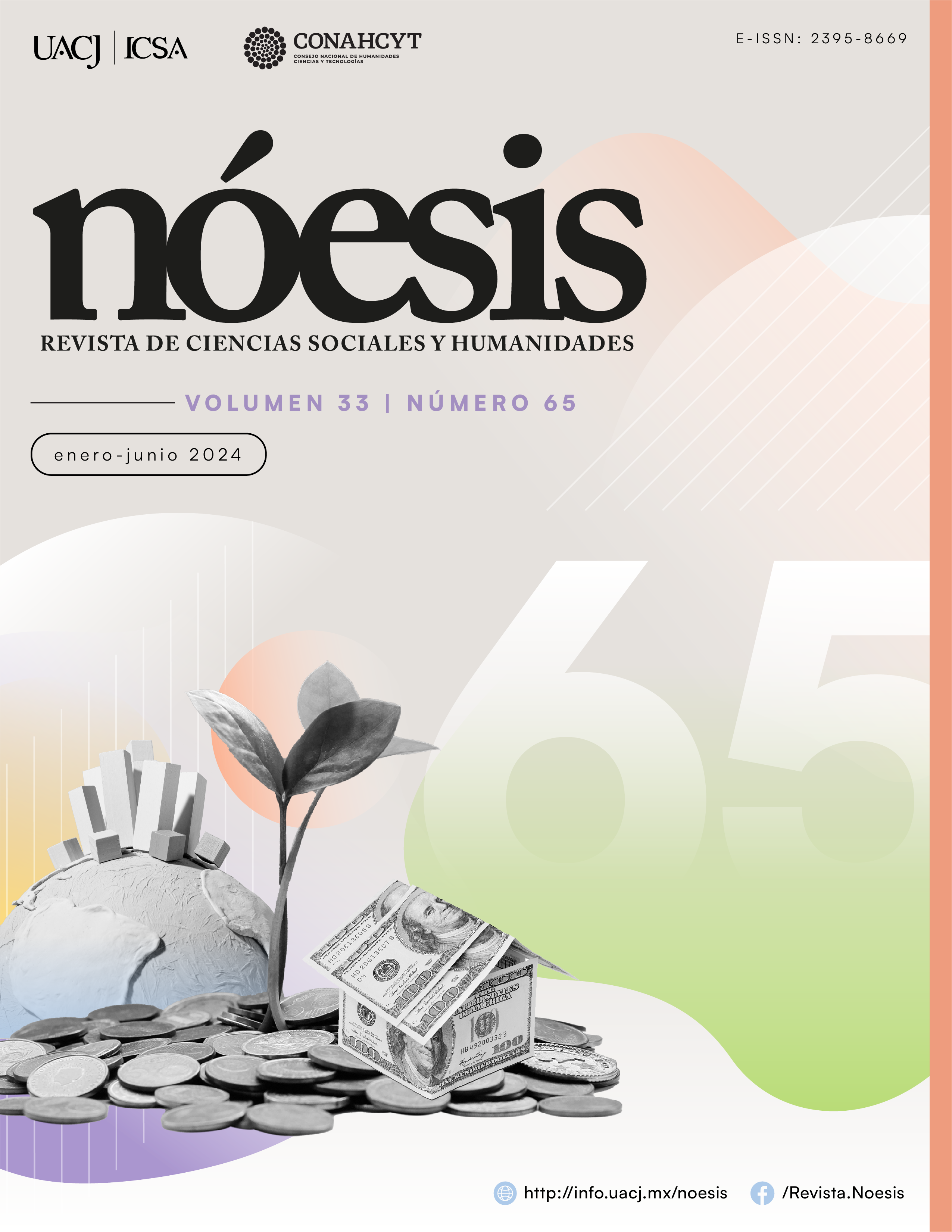Efectos del crecimiento económico en las emisiones de CO2 en América del Norte
Contenido principal del artículo
Resumen
Este artículo examina la heterogeneidad, en el ámbito ambiental, de los 3 países que componen la región de Norteamérica, específicamente en la emisión de CO2, el principal gas efecto invernadero. Por un lado, Estados Unidos es un gran emisor de CO2 (19% de las emisiones globales acumuladas en 1990-2020), solamente superado por China a partir de 2005. Por otro lado, Canadá y México son emisores relativamente pequeños a escala global (respectivamente 1.8% y 1.4% de las emisiones globales acumuladas en 1990-2020), pero con grandes diferencias económicas y tecnológicas. En estas condiciones, el objetivo de la investigación es encontrar diferencias y similitudes entre los tres países respecto de las tendencias de emisiones de CO2 y sus factores estructurales conductores: los efectos escala, tecnológico y composición, con base en datos anuales de 2001 a 2014. Con un análisis de descomposición estructural, se encontró que, en general, el efecto escala fue contaminante y dominó en el periodo, mientras que el efecto tecnológico resultó anticontaminante, además de un efecto composición pequeño y ambivalente (positivo en unos años y negativo en otros). Se concluye que hay un proceso de convergencia en la intensidad de emisiones por valor del PIB y respecto de los tres efectos mencionados. También se concluye que las características de los tres efectos en México fueron parecidas a las de Estados Unidos, a las cuales Canadá se aproximó durante el periodo de análisis.
Descargas
Detalles del artículo

Esta obra está bajo una licencia internacional Creative Commons Atribución-NoComercial-CompartirIgual 4.0.
Citas
Alier, J. M., & Roca, J. (2015). Economía ecológica y política ambiental. Fondo de Cultura Económica.
Andreoni, V., & Galmarini, S. (2016). Drivers in CO2 emissions variation: A decomposition analysis for 33 world countries. Energy, 103, 27-37. DOI: https://doi.org/10.1016/j.energy.2016.02.096
Banco Mundial. (3 de abril de 2023). World Bank national accounts data, and OECD National Accounts data files. Banco Mundial. Datos. https://www.worldbank.org/en/home
Banco Mundial. (11 de julio de 2023). World Development Indicators. Banco Mundial. Datos. https//:databandk.worldbank.org/reports.aspx?source=World-Development-Indicators#
Casler, S. D., & Rose, A. (1998). Carbon Dioxide Emissions in the U.S. Economy: A Structural Decomposition Analysis. Environmental and Resource Economics, 11(3/4), 349-363. DOI: https://doi.org/10.1023/a:1008224101980
Corsatea, T., Lindner, S., Arto, I., Román, M., Rueda-Cantuche, J., Velázquez Afonso, A., .Neuwahl, F. (2019). World Input-Output Database Environmental Accounts. Seville (Spain): European Commission.
Dietzenbacher, E., & Los, B. (1998). Structural Decomposition Techniques: sense and sensitivity. Economic Systems Research, 10(4), 307-324. DOI: https://doi.org/10.1080/09535319800000023
González, D., & Martínez, M. (2012). Decomposition analysis of CO2 emissions in the Mexican industrial sector. Energy for Sustainable Development, 16(2), 204-2015. DOI: https://doi.org/10.1016/j.esd.2012.01.005
Kaivo-oja, J. L., Panula-Ontto, J., Vehmas, J., Chen, Y., Mikkonen, S., & Auffermann, B. (2014). Are structural change and modernisation leading to convergence in the CO2 economy? Decomposition analysis of China, EU and USA. Energy, 72, 115-125. DOI: https://doi.org/10.1016/j.energy.2014.05.015
Macías, A. (2015). Actividad económica y daño ambiental: un análisis estructural para México. [Tesis de maestría en Economía. Ciudad de México: El Colegio de México]. https://repositorio.colmex.mx/concern/theses/m613mx88c
Miller, R. E., & Blair, P. D. (2009). Input-output analysis: foundations and extensions. Cambridge University Press.
Sesso, P. P., Amâncio-Vieira, S. F., Zapparoli, I. D., & Sesso Filho, U. A. (2020). Structural decomposition of variations of carbon dioxide emissions for the United States, the European Union and BRIC. Journal of Cleaner Production, 252. DOI: https://doi.org/10.1016/j.jclepro.2019.119761
Shahbaz, M. G., Adom, P. K., & Hammoudeh, S. (2019). The technical decomposition of carbon emissions and the concerns about FDI and trade openness effects in the United States. International Economics, 159, 26-73. DOI: https://doi.org/10.1016/j.inteco.2019.05.001
Sheinbaum-Pardo, C., Mora-Pérez, S., & Robles-Morales, G. (2012). Decomposition of energy consumption and CO2 emissions in Mexican manufacturing industries: Trends between 1990 and 2008. Energy for Sustainable Development, 16(1), 57-67. DOI: https://doi.org/10.1016/j.esd.2011.08.003
Su, B., & Ang, B. (2012). Structural decomposition analysis applied to energy and emissions: some methodological developments. Energy Economics, 1(34), 177-188.
Talaei, A., Gemechu, E., & Kumar, A. (2020). Key factors affecting greenhouse gas emissions in the Canadian industrial sector: A decomposition analysis. Journal of Cleaner Production, 246. DOI: https://doi.org/10.1016/j.jclepro.2019.119026
Timmer, M. P., Dietzenbacher, E., Los, B., Stehrer, R., & De Vries, G. J. (20105). An illustrated user guide to the world input–output database: the case of global automotive production. Review of International Economics, 23(3), 575-605. DOI: https://doi.org/10.1111/roie.12178
Vinuya, F., DiFurio, F., & Sandoval, E. (2010). A decomposition analysis of CO2 emissions in the United States. Applied Economics Letters, 17(10), 925-931. DOI: https://doi.org/10.1080/00036840902762688
Wang, H., Ang, B. W., & Su, B. (2017). A Multi-region Structural Decomposition Analysis of Global CO 2 Emission Intensity. Ecological Economics, 142, 163-176. DOI: https://doi.org/10.1016/j.ecolecon.2017.06.023

